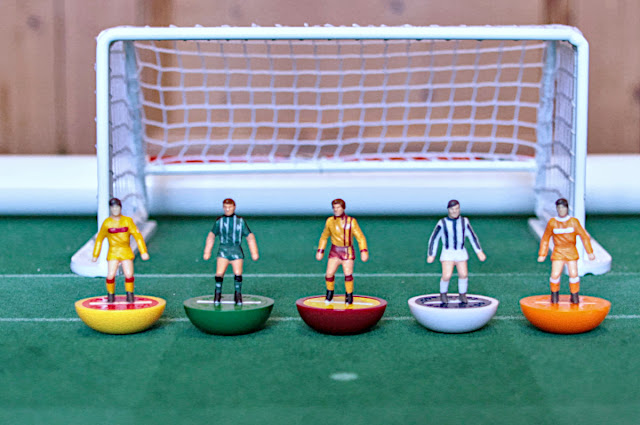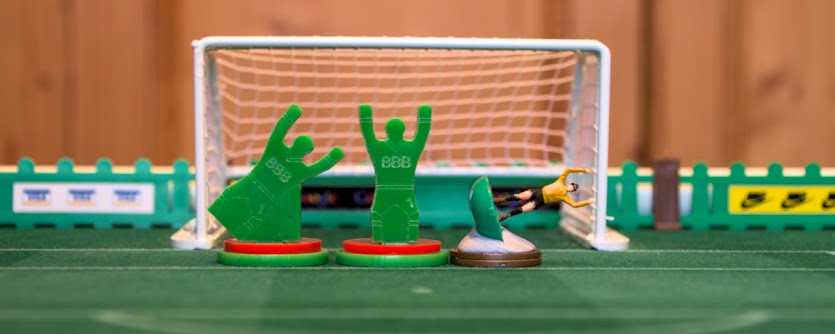Back To Basics
So What’s The Problem
As solo players most of us try to keep away from setting up for goal kicks with the 7 defenders spread across the shooting line and 3 wee fellas hovering around between the shooting areas, it doesn’t seem real, and adds nothing to enhance our furtive imaginations, or make each game somewhat different from the last. Even so my games started to feel the same when setting the field for goal kicks, I wasn’t using the 7-3 style, but I seemed almost subconsciously to be setting up in fixed positions every goal kick.
 |
| New additions to the collection for next season, a mixture of Topspin, and Santiago
Possible Solutions After speaking to a few other solo players I had about my perceived problem, I had a few more ideas to mull over, from keeping loosely to teams original formation, to just use the old backwards and sideways in the opposing half method. Two sound pieces of advice, but I still had slight issues with them. Before you say it yes some people are hard to please, and it seems I’m one of them. Loosely using the teams formation is great until you feel that team may need to press a little more, or try and defend a slender lead, the old sideways and backwards method will always depend on how many players one has in the oppositions half. So although they are sound suggestions, and would obviously allow teams to reset on such occasions I felt it could be better from my standpoint. Ideas I’m Having I want something that can afford teams the luxury of pressing a game to get that equaliser, or trying to defend a slender lead, a rule which sets out the constraints but can be applied however to give each team a way to set up accordingly to the situation it finds itself in. You
may be thinking at this point what’s his problem was he dropped on
his head as a baby, or maybe he’s just paranoid. Well if I was to
answer those questions in one word, it would be no, but
being dropped on my head as a baby could have happened according to
my Wife.
Anyway lets move on I want to set up for a goal kick without trying to out think myself, but have players in key areas, so I came up with the following.
Players may be picked up and positioned, (attacking side first). Subject to the following: i) Players are not allowed to be placed inside their opponents shooting area all players inside the area must be placed outside. ii) Players in the opposing half may not be placed within 90mm of their opponents Shooting Line. iii) At least 2 but no more than 4 figures must be placed within each of the quarters between the shooting areas. iv) At least 2 players in their defensive quarter, outside of their shooting area must be positioned closer to halfway than their own shooting line, any remaining figures to be placed anywhere in that quarter, but no closer than 25mm to the shooting line. v) At least 2 but no more than 5 figures must be placed inside their own shooting area but not in the penalty area for defence, (inside the shooting area means inside and approximately 25mm from the shooting line). At first look it could appear a little complicated, but in reality, it spreads the players out loosely in some form of a recognisable formation as well as allowing a team to press or defend as the situation demands. By limiting how many and how close players can be to the relevant shooting areas stops the formations becoming merged at the back as seems to be the norm in Tournament play. It also stops me even contemplating blasphemy in my solo games. Does it Work in Practice For me yes it’s stringent enough to spread the players out, but allows enough leeway to be attack or defensive minded, without having packed defences or an over populated forward line. I’ve tried it a few times now, and it seems to be working so far. Now I’m not trying to convince anyone that this is any better than any other method, but it achieves my aims, and it’s adaptable to the various situations that occur or that teams find themselves in, without being too taxing on the old grey matter. I’m now seriously thinking of including it next season in the Bonfire Alliance. Like all “House Rules”, it needs to serve a purpose in the grand scheme of things, and cure not cause problems, for me I feel it does that, well at least in the few games I’ve trialed it in. I’ve put a graphic explanation Here if anyone’s interested. Another End of Season Tournament At the end of last season David Forsyth and myself, combined our Solo Leagues by allowing 4 teams from each league to compete in a joint Solo venture called the Brookfield and Bonfire Alliance Trophy. Or The B&B Trophy for short. We've decided to give it another go, as we both felt last seasons competition worked quite well, and was an enjoyable venture. This time around a slight name change has been made to coincide with Subbuteo’s 75th birthday. So the name of the competition is now The Peter Adolph Memorial Trophy, the format will be the same, Brookfield v Bonfire Alliance quarter finals, with both David and I playing the respective home legs, then aggregating the scores after the matches have been completed to determine the semi finalists The full format can be found Here Which has been simplified a little from last season. So as they say watch this space. New Strips for Next Season I’ve been lucky enough to acquire 5 used teams, to compliment my small collection of Heavyweight replicas so now colour clashes will be less of a problem in next seasons Bonfire Alliance. The teams are a mixture of Santiago, and Topspin. To make them a little more unique I’ve purchased some different coloured discs to even further enhance identification on the pitch, my eyes aint what they used to be and some colours are not as distinguishable as they used to be. The new acquisitions can be seen in the photo accompanying this post. I really like the Motherwell kit, and so did newly promoted Maresfield Albion, and have adopted it for the coming season, and will be sporting it in the P.A. Memorial Trophy, as the Championship Champions automatically qualify along with the Premier Leagues top 3. It’s now my close season, (apart from the P.A. Memorial Trophy), so I’ll be pursuing other interests, but at the same time getting ready for another solo season, and trialing no doubt some ideas that I’ll share along the way. Keep on Flicking Ian
|



Your diagram certainly helps explain what you are trying to achieve.
ReplyDeleteAlso, a panoramic view of these formations during game play looks both realistic and impressive.
It may be the way I play, but I found that the combination of heavyweight figures and the FF ball tended to produce the more defensive formations, as one well hit pass can take out an opposition's midfield all to easily, hence dropping back at goal kicks.
The teams which kept them there, and just relied on "a front three" in attack, achieved better results.
This difference became much less noticeable when the heavyweights were replaced with lightweights and especially 'flats'.
Hi David, It will always be a case of each to their own, in solo play there will never be a one size fits all method. For me it stops the 7-3 formations being employed, as well as looking visually better and it keeps some sort of realistic formation. But as you've commented which is also a very valid point is the equipment used can be and often is a factor in the way we play, and often does effect our house rules and tactics.
Delete